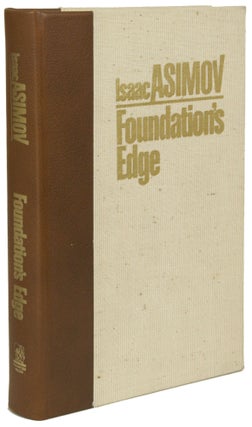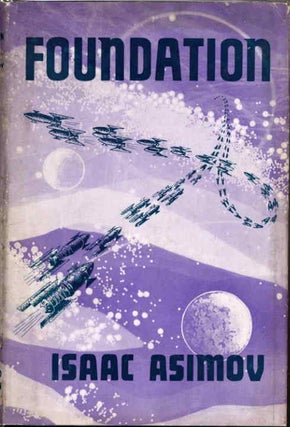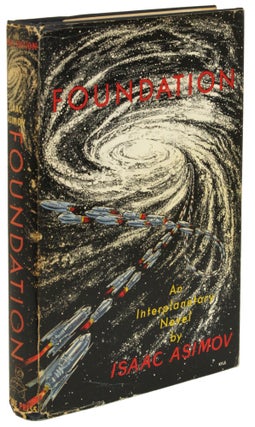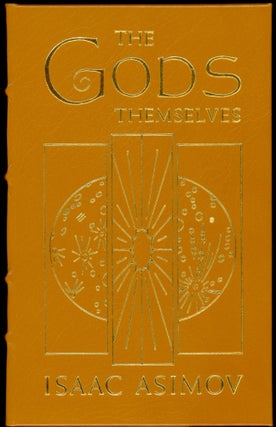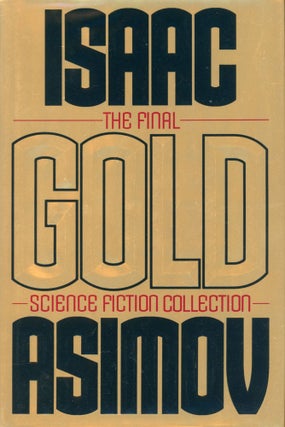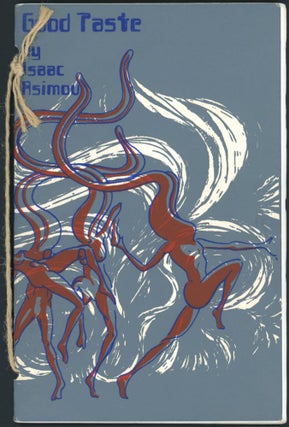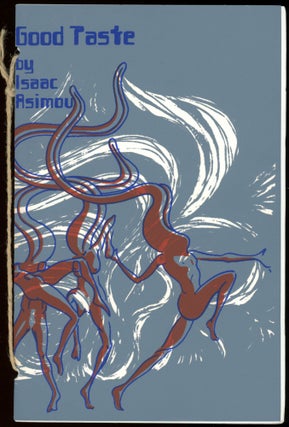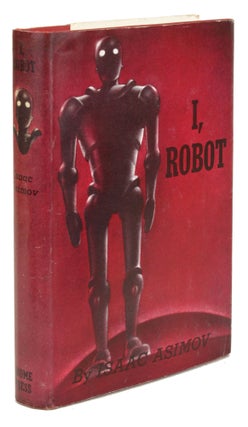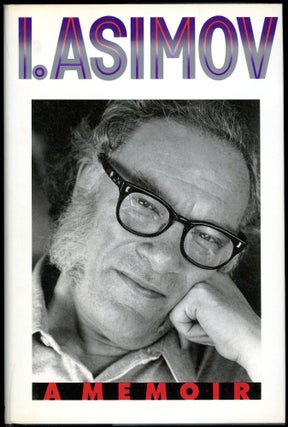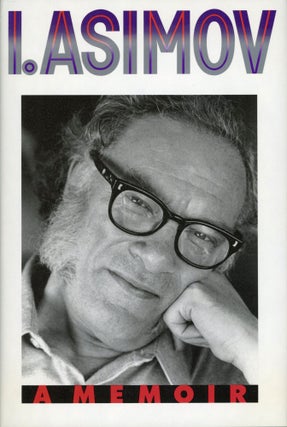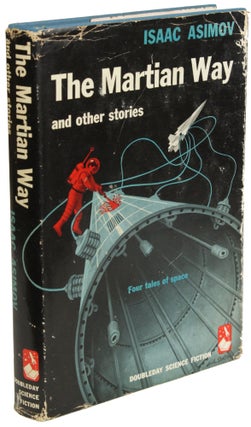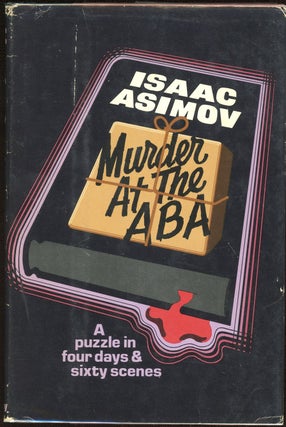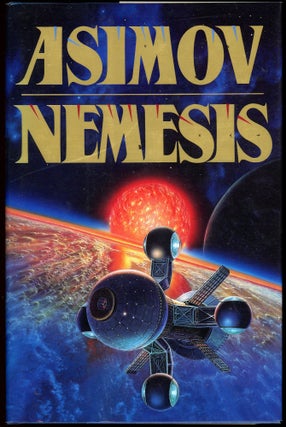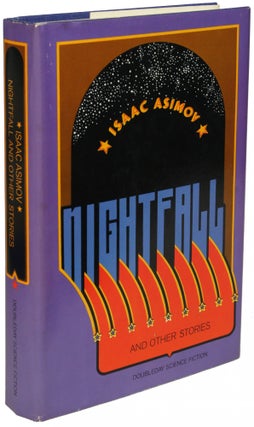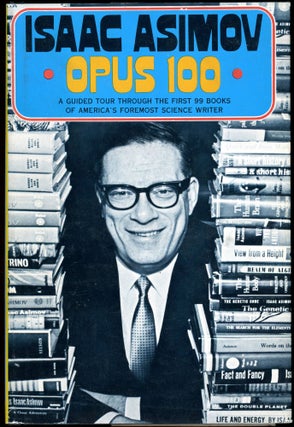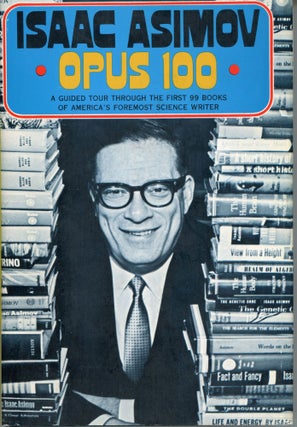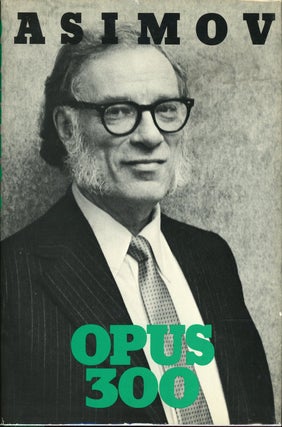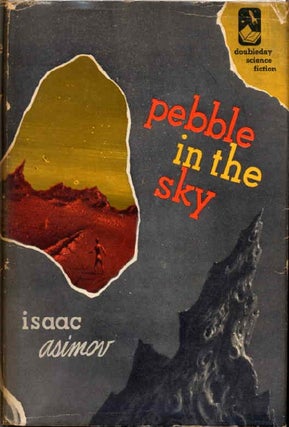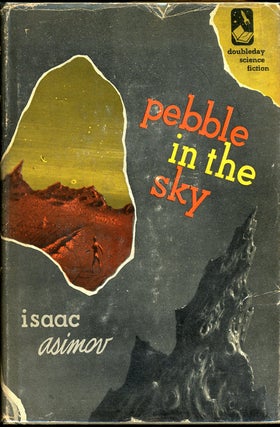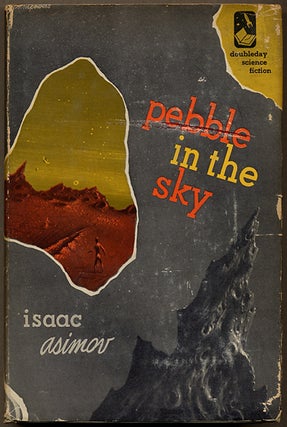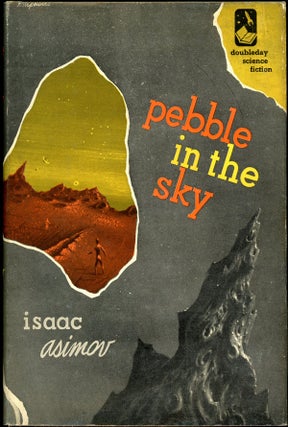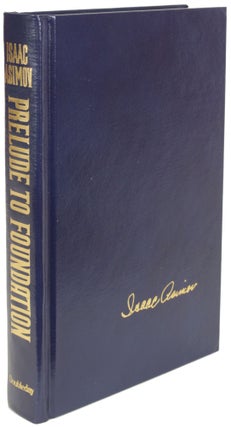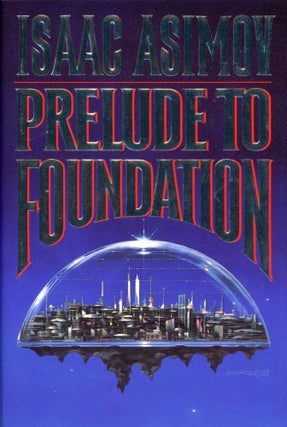Results
FOUNDATION'S EDGE.
[Binghamton]: Whispers Press, 1982. Octavo, leather-backed linen. First edition. One of 1000 numbered copies signed by Asimov and publisher Stuart Schiff. "A belated sequel to the 'Foundation Trilogy,' marking Asimov's return to his distinctive brand of cerebral space opera after more than twenty years. In this yarn (and the related novels THE ROBOTS OF DAWN, ROBOTS AND EMPIRE, FOUNDATION AND EARTH and PRELUDE TO FOUNDATION) Asimov explains the galactic history of THE STARS LIKE DUST and the "Foundation" series as a plot by the robots (from the otherwise unconnected 'Robot' stories) to ensure the survival and happiness of the human race, and hints that the history-altering time travelers of THE END OF ETERNITY set up the whole thing." - Pringle, The Ultimate Guide to Science Fiction, second edition (1995), p. 143. Winner of the 1983 Hugo award. 1982 Nebula nominee. Anatomy of Wonder (2004) II-47. Sargent, British and American Literature, 1516-1985, p. 410.
FOUNDATION.
London: Weidenfeld & Nicolson, 1953. Octavo, Hardcover. First British edition. First book in the Foundation series.
FOUNDATION.
New York: Gnome Press, Publishers, [1951]. Octavo, jacket painting by David Kyle, cloth. First edition, first binding. The first volume in the Foundation series, awarded a special Hugo award in 1966 for best all-time series. Anatomy of Wonder (1995) 3-12. Survey of Science Fiction Literature II, pp. 819-31.
THE GODS THEMSELVES.
Norwalk, CT: The Easton Press, [1986]. Octavo, illustrations by Richard Powers, full leather, a.e.g. Later edition. New introduction by James Gunn. "In the twenty-second century, Earth and men of a para-universe establish an ideal energy exchange. Through Earthmen's electron pump and the para-men's position pump, the energy needs of both worlds are satisfied without energy loss to either. A few probing skeptics, men and para-men, learn that in time the exchange will explode our Sun, but both scientific establishments ignore their alarm. The 'fathers' of the energy pumps, puffed with pride and selfishness, will not allow their reputation, doctrine, and achievement to be jeopardized ... The blind egotism and leaden conscience of his [Asimov's] scientific establishments offer no promise that a world ruled by scientists rather than politicians would be more free of it." - Berger, Science Fiction and the New Dark Age, p. 130. THE GODS THEMSELVES ... which was only the second genuine singleton of his career and which won both Hugo and Nebula awards, proved to be his finest single creation, a complex tale involving potentially catastrophic energy transfers between alternate universes and -- rarely for him -- intriguing alien beings (they are considerably more interesting than the humans in the cast)." - John Clute / Malcolm J. Edwards, SFE (online). Written with a verve and economy that are missing from Asimov's later novels." - Anatomy of Wonder (2004) II-48. Winner of the 1972 Nebula award and 1973 Hugo award for best novel. Collector's notes laid in. Issued as part of the Easton Press "Masterpieces of Science Fiction" series. Survey of Science Fiction Literature II, pp. 909-14.
GOLD: THE FINAL SCIENCE FICTION COLLECTION.
[New York]: HarperPrism, [1995]. black cloth stamcloth backed boards.ped in gold and blind. First edition. Part of the limited issue comprising 1226 numbered copies, this being number 394. Collects fifteen short stories, eighteen essays, and twenty articles on writing science fiction.
GOLD: THE FINAL SCIENCE FICTION COLLECTION.
[New York]: HarperPrism, [1995]. Octavo, cloth-backed boards. First edition. Collects fifteen short stories, eighteen essays, and twenty articles on writing science fiction.
GOOD TASTE.
[Topeka, KS: Apocalypse Press, 1976]. Octavo, decorated wrappers, sewn. A chapbook. First edition. Limited to 1012 copies of which this is one of 500 numbered copies signed by Asimov.
GOOD TASTE.
[Topeka, KS: Apocalypse Press, 1976]. Octavo, decorated wrappers, sewn. First edition. Limited to 1012 copies of which this is one of 500 numbered copies signed by Asimov. A chapbook. Short story.
I, ROBOT.
New York: Gnome Press, Inc., Publishers, [1950]. Octavo, illustrated by Edd Cartier, cloth. First edition. Influential collection of short fiction about robots with first postulation of the "Three Laws of Robotics," a concept used for plots in numerous tales by other writers in subsequent years. Includes "The Evitable Conflict." in which machines that have made the world of the twenty-first century an economic utopia take control of Mankind's future, moving it "toward an unknown and happy destiny." - Berger, Science Fiction and the New Dark Age, pp. 36-7. Loose basis for the recent film of the same title. Anatomy of Wonder (2004) II-49. Survey of Science Fiction Literature II, pp. 995-99.
I. ASIMOV: A MEMOIR.
New York, London, Toronto, Sydney, Auckland: Doubleday, [1994]. Octavo, illustrations, cloth backed boards. First edition. Winner of 1995 Hugo Award for best nonfiction book.
I. ASIMOV: A MEMOIR.
New York, London, Toronto, Sydney, Auckland: Doubleday, [1994]. Octavo, pp. [i-vii] viii-ix [x-xi] xii [xiii-xiv] [1] 2-562, illustrations, cloth-backed boards. First edition. Winner of 1995 Hugo Award for best nonfiction book. Published posthumously, with an epilogue by his wife, and a checklist of Asimov's books.
THE MARTIAN WAY AND OTHER STORIES.
Garden City, New York: Doubleday & Company, Company, Inc., 1955. Octavo, boards. First edition. Asimov's first collection of short fiction. Collects "The Martian Way," "Youth," a first contact story, "The Deep," an amusing Earth invaded by aliens satire, and "Sucker Bait," all written between 1952 and 1954. "Good traditional SF of the period." - Anatomy of Wonder (1987) 3-21. Most of the best of his short stories ... were initially assembled in a series of impressive volumes, including THE MARTIAN WAY AND OTHER STORIES (1955), EARTH IS ROOM ENOUGH: SCIENCE FICTION TALES OF OUR OWN PLANET (1957) and NINE TOMORROWS: TALES OF THE NEAR FUTURE (1959). Anatomy of Wonder (1987) 3-21.
MURDER AT THE ABA ...
Garden City: Doubleday & Company, Inc., 1976. cloth-backed boards. First edition.
MURDER AT THE ABA: A PUZZLE IN FOUR DAYS AND SIXTY SCENES.
Garden City, New York: Doubleday & Company, Inc., 1976. Octavo, cloth backed boards. First edition. Mystery.
NEMESIS.
New York, London, Toronto, Sydney, Auckland: Doubleday, [1989]. Octavo, cloth backed boards. First edition. The solar system is imperiled by an approaching star and about a conspiracy to conceal a threat to our solar system. "The action alternates between a young girl growing up on Rotor, a space habitat which has traveled to a red dwarf star that is approaching the solar system, and her father on Earth, who is involved in a project to build a starship." - Pringle, The Ultimate Guide to Science Fiction, second edition (1995), p. 251.
NIGHTFALL AND OTHER STORIES.
Garden City, NY: Doublday & Company, Inc., 1969. Octavo, cloth. First edition. Includes the title story and nineteen others. Asimov provides an introduction to each story. "Nightfall" is one of the classic stories of Science Fiction, "his most famous story and probably the single most famous US sf story of all time." - John Clute and Malcolm Edwards, SFE (online). Anatomy of Wonder (2004) II-50.
OPUS 100.
Boston: Houghton Mifflin Company, 1969. Octavo, cloth. First edition. A collection of fiction and nonfiction selected from previously published books.
OPUS 100.
Boston: Houghton Mifflin Company, 1969. Octavo, cloth. First edition. A collection of fiction and nonfiction selected from previously published books.
OPUS 300.
Boston: Houghton Mifflin Company, 1984. Octavo, cloth backed boards. First edition.
PEBBLE IN THE SKY.
Garden City, New York: Doubleday & Company, Inc., 1950. Octavo, jacket illustration by Richard Powers, cloth. First edition. The author's first book. Anatomy of Wonder (1995) 3-15.
PEBBLE IN THE SKY.
Garden City: Doubleday, 1950. Octavo, jacket illustration by Richard Powers, Hardcover. First edition. Author's first book. Anatomy of Wonder (1995) 3-15.
PEBBLE IN THE SKY.
Garden City: Doubleday & Company, Inc., 1950. Octavo, jacket illustration by Richard Powers, cloth. First edition. The author's first SF novel. Anatomy of Wonder (1995) 3-15.
PEBBLE IN THE SKY.
Garden City: Doubleday & Company, Inc., 1950. Octavo, jacket art by Richard Powers, cloth. First edition. The author's first SF novel (and first book). In the far future "Earth is largely a radioactive wasteland, populated by a few million inhabitants who are discriminated against by the rest of the galactic empire which has forgotten that Earth was humanity's original home." - Brians, Nuclear Holocausts: Atomic War in Fiction, 1895-1984, p. 122. Anatomy of Wonder (2004) II-51. Sargent, British and American Utopian Literature, 1516-1985, p. 237. In 333.
PRELUDE TO FOUNDATION.
New York: Doubleday, 1988. Octavo, imitation leather, all edges gilt. First edition. One of 500 numbered copies signed by Asimov. Prequel to the Foundation series. "Includes a description of a society presented as dystopian that is similar to a traditional religious commune." - Sargent, British and American Utopian Literature, 1986-2009. Sargent, British and American Utopian Literature, 1986-2009.
PRELUDE TO FOUNDATION.
New York: Doubleday, 1988. Octavo, cloth-backed boards. First edition, first printing without "first edition" statement on copyright page. Prequel to the Foundation series. "Includes a description of a society presented as dystopian that is similar to a traditional religious commune." - Sargent, British and American Utopian Literature, 1986-2009. Sargent, British and American Utopian Literature, 1986-2009.

